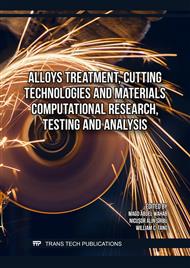p.3
p.11
p.19
p.35
p.49
p.59
p.73
p.81
Effect of Annealing on the Hardness Variation and Deformation Behaviour of W-Ni-Cu and W-Ni-Fe Alloys
Abstract:
As aerospace, nuclear engineering, and other high-technology industries continue to advance, the demands for material properties have grown more stringent. Strengthened via the intrinsic thermally stable element tungsten (W) with the ductile γ phase, tungsten heavy alloys (WHAs) have emerged as critical materials for extreme service conditions in multiple fields due to their high density, outstanding strength, radiation resistance, and excellent high-temperature performance. However, their application is limited by certain drawbacks such as high temperature/irradiation conditions, interfacial weakening and room-temperature brittleness. This study investigates the effect of annealing on the microstructural evolution and hardness behaviour of W-Ni-Fe and W-Ni-Cu alloys through the Vickers hardness tests, crystal structure, morphology and elemental distribution analysis. The W-Ni-Fe and W-Ni-Cu alloys exhibit remarkable hardness stability during annealing, with less affected by temperature, confirming the excellent thermal stability. W-Ni-Fe alloys exhibit softening phenomena during high-temperature annealing, while the W-Ni-Cu alloys demonstrate enhanced hardness through annealing. This discrepancy is originally caused by the differences in the diffusion behaviour of the two binder phases (NiFe/NiCu) at elevated temperatures and their distinct interfacial interaction mechanisms with the W matrix.
Info:
Periodical:
Pages:
3-9
Citation:
Online since:
November 2025
Authors:
Keywords:
Price:
Сopyright:
© 2025 Trans Tech Publications Ltd. All Rights Reserved
Share:
Citation:


